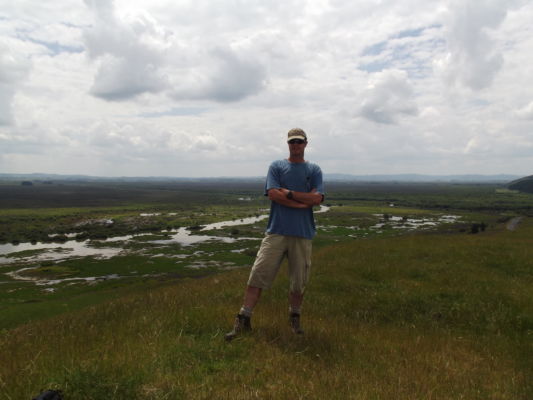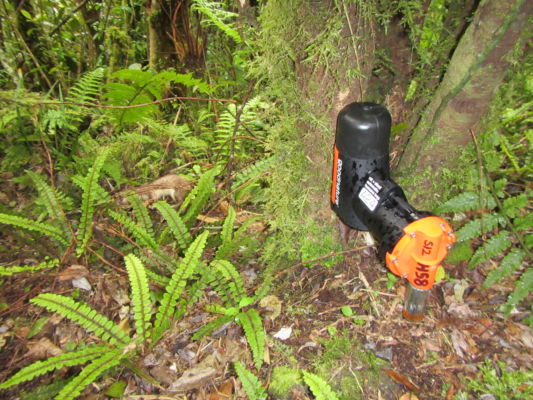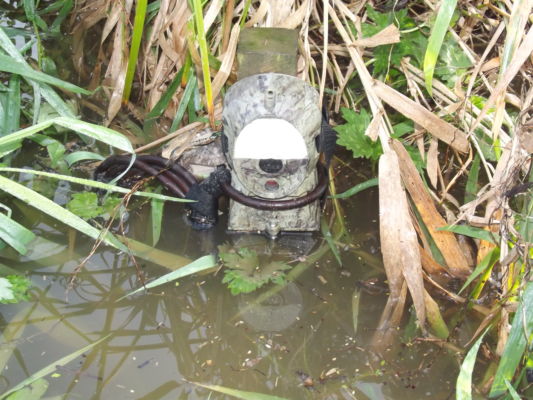When Craig Gillies from DOC’s Hamilton office first started studying feral cats at the University of Auckland, he visited Department of Conservation ‘old hand’ Dick Veitch – since retired – who gave him a piece of advice that has stuck with him throughout his conservation career: “It’s not the ones you catch that matter,” said Dick, “It’s the ones you didn’t catch.”
Now, 20 odd years later, Craig is just wrapping up a 5½ year study of Goodnature self-resetting traps – evaluating new and better ways to catch predators. Between 2010 and 2014 he was also carrying out field work monitoring predators in the Whangamarino Wetland in North Waikato – finding the best ways to detect predators that haven’t been caught, as Dick advised. He also sits on NAEAC (National Animal Ethics Advisory Committee) to advise on environmental and conservation management issues. Add to that, his role as predator control advisor for the Kiwi Recovery Group and it’s clear that he is a busy man with his expertise on introduced mammalian predators also valued by community groups in the region.
Craig’s main research emphasis is on the ecology of feral cats, mustelids and rats and how best to control and monitor them. During his study, he’s seen an evolution in the development of self-resetting traps.
“We carried out field trials around the country on Goodnature A12 (possums) and A24 traps for rats and stoats. Initially there were problems with mechanical reliability and we had to structure the trial to cope with that,” Craig says, “Now there is vastly improved reliability. I’m really excited about the potential for rats. The automatic lure pump for rats has unlocked the potential for rat control. It’s a cool way to get to the end of the project.”
An independent engineering review of the A24 trap has also confirmed mechanical reliability.

As yet there is no automatic lure pump for stoats, so in the last field trial for the Goodnature trap study, Connovation’s stoat lure ‘Erayz’ was used in A24 traps and refreshed every 3 weeks. Goodnature is working on a new stoat lure, but Craig has not tested it to date.

The most recent and final field trial on the self-resetting traps has been carried out with kiwi at Trounson Kauri Park, near Dargaville – the Department of Conservation’s first ‘mainland island’ in Northland. In the 2015/2016 breeding season 32% of the chicks in the study sample survived to reach a safe weight with A24 traps used to control stoats. That’s comparable to survival rates in previous years using ‘old’ methods.
“All that’s needed now is an automatic stoat lure pump like that used for rats,” says Craig. “It’s an effective stoat trap, but it needs a long-life lure. If we had an effective long-lifelure, we could definitely control stoats more cost effectively, so I’m excited by the potential for stoat control,” he says.
The self-resetting project is coming to an end, but Craig won’t be retiring to his desk any time soon. There’s still more predator monitoring trials to follow-up on from the Whangamarino work to lure him out of the office.
When he started the Whangamarino project in 2010, not much was known about the pest mammal guild in wetland habitats.
“We didn’t know how to monitor mammal pests in a big wetland,” Craig explains. “The research brief was to develop, test and validate small mammal monitoring techniques and to see how predators responded with the water level was very high.”
The project began with 17 live trapping sessions over a 3-year ‘pre-control’ period to establish what predators were present and in what numbers. Animals were captured alive, marked and then recaptured. Every mammal predator was found; the only ones we weren’t live capturing were possums but there were heaps of them in there too.
Monitoring techniques were then investigated.
“For carnivores – that’s feral cats and mustelids – camera trapping was used,” says Craig. “Peanut-scented wax tags were used for mice and rats.”
The results were fascinating – and distinctly different that the situation found in forests.
“We found that the predator guild was dominated by ferrets, then feral cats, then weasels, then relatively few stoats,” says Craig. “We ended up catching hedgehogs as well, but not as many rats as expected. The ratio of ship rats to Norway rats was 60:40. In a forest it’s about 90% (or higher) ship rats.”
Then there were the mice.
“Teeming” is how Craig describes mouse numbers in the parts of the wetland where he was working.
“The trail cameras were excellent for monitoring ferrets and very good for cats,” Craig says, “The lure was fresh rabbit.”
There weren’t enough stoats and weasels detected, however, to assess how well trail cameras worked for them and this is the work he’d like to follow-up on in forested environments for his next project. Camera spacing may not have been right for weasels, Craig thinks.
“We caught a lot of rats. The wax tags were good for rats and excellent for mice.”
Being wax, it also doesn’t matter if the wax tags get flooded. It’s a different story for trail cameras.
“I put the cameras as low as I could get away with,” says Craig.
No trail cameras were lost to flooding, although water levels did get very, very close. There were, however, a significant number of cameras lost due to another mammalian predator patrolling the wetlands. The cameras were being used in a study of lures and self-resetting traps that Craig carried out in parallel to his predator monitoring research.
“We needed to film pest behaviour at the self-resetting traps because so much of what is killed is scavenged even in a couple of days. So we had 300 trail cameras out in study sites around the Waikato. Most of them were well away from where people were likely to go, but we lost heaps.”

Trail cameras don’t come cheap. They can cost anything from $250 for a basic model to over $900 for the expensive ones.
“They’re like lollies,” says Craig. “We had a lot stolen in the Waikato, if it’s found – it’s gone. It’s just too much temptation.”
Many of the cameras were housed in security cases and well hidden in tight scrub. They were set out at a spacing of 1 every 100m.
“I don’t know how they found some,” says Craig. “Maybe they saw them being checked. One weekend we lost 19 camera traps on a line of 30.”
For Craig, it’s not just the cameras that are lost.
“There’s ½ to a week’s worth of footage and good quality rechargeable batteries.”
The cameras themselves are all password protected, so not a lot of use to anyone else.
“When the 19 camera traps were taken, we found alcho-spirit bottles at the same location. They’ve been finger-printed by the police, but the fingerprints aren’t in the system.”
It is frustrating as well as an expensive drain on limited budgets – and it’s a common problem where-ever trail cameras are used.
“I’ve even heard of some groups that are using cameras to monitor their cameras,” says Craig.
It may be the way to go.

With his research interests so closely aligned with the volunteer work being done by community groups, it’s not surprising that Craig is often called upon to talk to conservation groups in the community. It’s something he’s very happy to do – but, given his busy research schedule, it’s probably a good idea to contact him well in advance.
His advice to community groups beginning a new conservation project is to think, right at the start, about what conservation values you are trying to protect and what are the threats to those values.
“That determines what pests you need to target and when. It also allows you to determine whether your project is working.”
“Detail counts,” Craig emphasises. “Predator control must be done to a high standard. You need to keep up to date with developments and seek advice. Traps need to be set well; wooden trap tunnels need to be firmly seated on the ground with entrances kept clear. They need to be kept clean, well lured and well maintained. With every trap, think ‘how is the animal going to get in and get caught?’”
Good monitoring is also important.
“You might kill a lot, but it’s not the killing that matters. Predator numbers need to be low enough to allow native species to breed successfully,” Craig says. “You need to monitor natives and residual pest abundances. What you didn’t catch is important.”
Dick Veitch’s advice to Craig is still highly relevant to predator control today. ‘It’s what you don’t catch that matters…’
Finally, Craig also emphasises animal welfare – both the need to be aware of other animals that might be at risk from traps and the welfare of the pest species you’re targeting.
“Be professional. Use kill traps that are humane and that have passed the NAWAC (National Animal Welfare Advisory Committee) standards. Don’t lose sight of the fact that you are killing animals to protect others. Do things to the highest standard,” he says.

